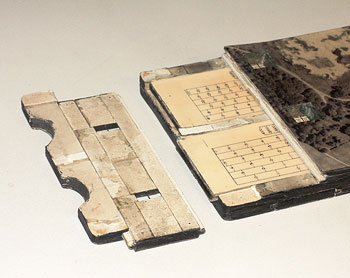 |
 Up
Up
|
|

|

|
A calculator hidden in a book |
|
|
|
|
|
|
At first glance the book “How many?”, by Charles Cornell, seems like any of the small hardcover books common a century ago. But when you open the cover you see it’s just a carefully padded box that contains a strange calculating device, bearing the title “F.24 Photographic Calculator”, and the name of C. H. Cornell. |
|
|
|
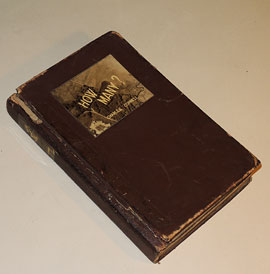
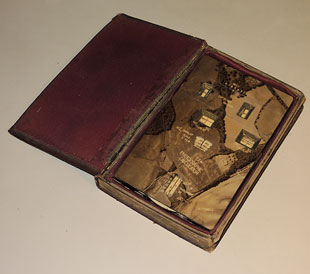 Click a photo to enlarge |
|
|
|
The calculator would pass for a “slide
chart”, that inexpensive poor relation of a slide rule, if it
weren’t much thicker and sturdier, and much more complex. To add to
the fun, its two faces are entirely covered in low-altitude aerial
photographs!DescriptionThe F.24 is a two-sided device, and measures 14.5x9.0x1.4 cm. counting both sides there are ten windows with hairlines (made from actual taut threads), through which scales on the inner parts can be read. |
|
|
|
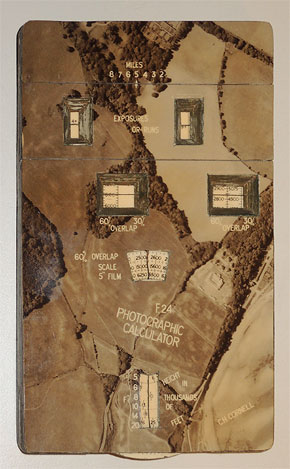
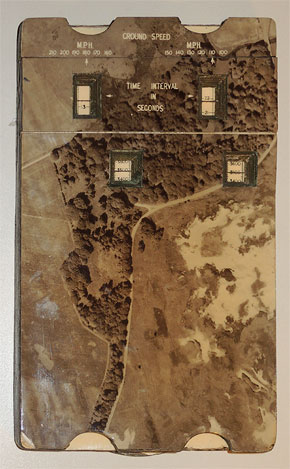 Click a photo to enlarge |
|
|
|
There are five moving parts: two sections of the faces that slide horizontally, two vertically sliding inner strips that are visible through cutout windows in the sliding and fixed sections, and a rotatable disc visible through two windows on the front side. You can see the possible motions in the photos below. |
|
|
|
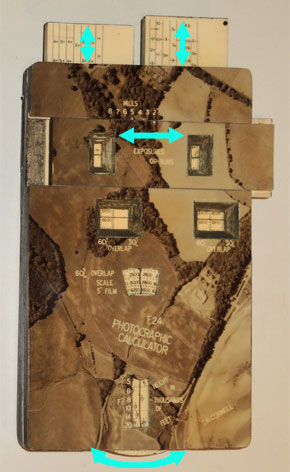
 |
|
|
|
What does it do? This device came with no documentation of any
kind, only mysteries: What does it do? Who built it, and when? And
lastly – why put it inside a fake book?! When was it made, where, and by who?Dating the F.24 calculator is tricky. Absent any reference to it anywhere I can find, I can’t give an accurate answer. Still, there are some hints:
|
|
|
|
 Click photo to enlarge |
|
|
|
So... looks like the F.24 calculator comes
from the 20s or 30s, basically the period between the two world
wars. As for country of origin -- the use of inches, feet and miles
place it in the UK or its (current or past) dominions, including the
US. Who produced it remains a mystery. Quite possibly it was the Charles H Cornell named on the device and “book” cover, but if so, we have yet to learn who he was; and since the book is a fake -- I can find no record of any book by that name -- there is no certainty that its author wasn’t imaginary as well. Operation detailsIt took me a while to figure out how the calculator works: I had no instruction manual, some of the readout windows lack captions, and it took a while to notice that someone before me had inserted one of the slides in backwards. Thus it is with some measure of pride that I report the successful reverse-engineering of the F.24. Here is the essence of the missing instructions, then: |
|
|
|
Variables Flight parameters: |
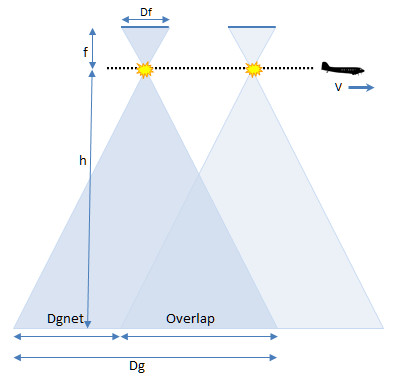 |
|
|
|
Formulas The planning of aerial photography is governed by basic geometry and kinematics. The formulas involved are as follows (assuming a sensible, i.e. Metric, system of units): Scale = h / f Dg = Df * Scale = (Df * h) / f Dgnet = Dg * (100% –Overlap%) N = L / Dgnet = L / (Dg * (100% –Overlap%)) Texp = Dgnet / v Of course this calculator is not based on Metric units, but its scale design takes care of both the calculation and the unit conversions needed to effect these formulas in Imperial units. Example problem An airplane flying 13,000 feet above the ground, at a speed of 160 MPH, needs to photograph a strip of land 3 miles long by snapping a sequence of exposures using a camera with a focal length of 10 inches and a film frame length of 5 inches. The exposures need to overlap by 60%. [Note: the F.24 is designed to only work with a 5” film and a 60% overlap.] Find the scale of the resultant photographs, the length of each frame on the ground in feet with and without overlap, the number of exposures needed, and the time between successive exposures. Solution procedure (blue numbers refer to the photos below):
|
|
|
|
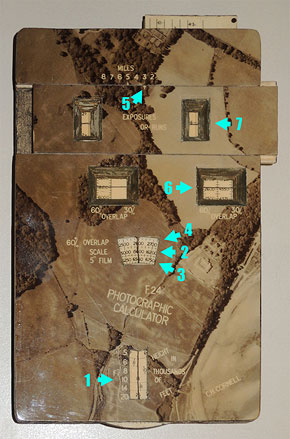
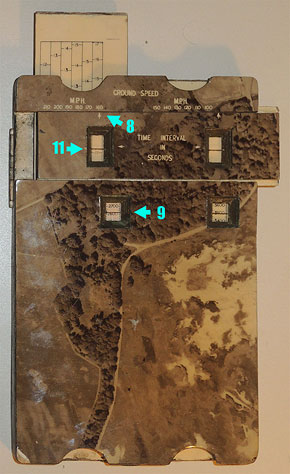 Click a photo to enlarge |
|
|
|
And why the fake book? The unusual book-like case inevitably conjures
romantic notions involving spies, smugglers, resistance fighters or
prisoners of war. These notions, however, don’t survive close
scrutiny. For one, if you wanted to smuggle a calculator to someone
behind enemy lines, you’d use a real book and make a hollow in some
glued pages, rather than a decorative but obviously fake box.
Besides, POWs and partisans could use a code book or a map
atlas, but they’d hardly have a need for planning reconnaissance
flights! |
|
|
|
Exhibit provenance: Found this one on eBay, from a seller in the UK. Unfortunately he got it from an antique merchant who had no further information. More info: |
|
|
|
|
|
|
|
Home | HOC | Fractals | Miscellany | About | Contact Copyright © 2016 N. Zeldes. All rights reserved. |
|
